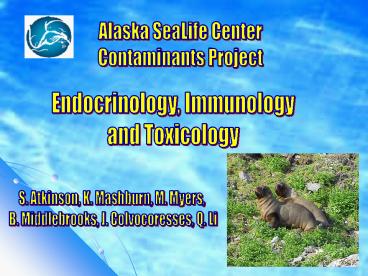Endocrinology, Immunology - PowerPoint PPT Presentation
1 / 13
Title:
Endocrinology, Immunology
Description:
Title: Slide 1 Author: Kendall Mashburn Last modified by: elizabethm Created Date: 2/20/2002 12:39:40 AM Document presentation format: On-screen Show – PowerPoint PPT presentation
Number of Views:74
Avg rating:3.0/5.0
Title: Endocrinology, Immunology
1
Alaska SeaLife Center Contaminants Project
Endocrinology, Immunology and Toxicology
S. Atkinson, K. Mashburn, M. Myers, B.
Middlebrooks, J. Colvocoresses, Q. Li
2
Background
- Man made chemicals are everywhere
- in virtually all living creatures and
environments
- Synthetic chemicals can mimic natural hormones
- upsetting normal reproductive and
- developmental processes
- Immunosuppression has also been linked
- to organic pollutants
- If pollution loads can act as endocrine
disruptors - and depress immunity, individuals may
experience - lowered survivability.
3
Background- Cont.
- While contaminants occur in low levels in
- many animals, due to the persistant nature
- of the compounds, body burdens increase
- with an increase in trophic level.
OBJECTIVE
- To look at the body burden of
- organochlorine and heavy metals compared to
- thyroid function (including retinol) and
- immunoglobulin values
4
The Function of Thyroid and Retinol Hormones
- Hormones represent an integrated response
- to a number of environmental and
physiological - factors that influence reproduction,
- growth, metabolism, and body condition.
- Thyroid hormones are involved in the
regulation - of energy management in mammals through
- changes in basal metabolic rate, the
absorption - of carbohydrates from the intestine,
- lipid metabolism, and heat production.
- Retinoic acid (vitamin A) must be present
- for protein synthesis to occur. Low levels
- contribute to decreased ability to make
antibodies.
5
Common Organochlorine Contaminants
DDT
DDT
2,2,5,5,- Tetrochlorobiphenyl
Primary Reproductive Steroids
Estradiol
Testosterone
Progesterone
6
Compounds Most Selectively Bound By Transthyretin
Dioxin
Thyroxine (T4)
Retinoic Acid
7
Single Hormone Action
8
PHOTOPERIOD/SEASON
EXTERNAL PERTURBATIONS Environmental
Change Disease Change in Food Abundance/Quality In
creased Predators Contaminants
STRESS
HYPOTHALAMUS
Releasing Hormones
Innervation Other Factors
PITUITARY
ADRENAL HORMONES GONADAL STEROIDS THYROXINE
9
Functions of Immunoglobulin Isotypes Found in
Mammals
- IgA
- Most prevalent immunoglobulin in mucosal areas
of the body (e.g. milk, saliva, tears) - Most important immuoglobulin in removing
bacteria from mucosal areas - IgD
- No known function, except activation of B cell
- IgE
- Involved in allergic responses
- Involved in response to parasites
- IgG
- Crosses placenta (in some species)
- Important in primary and secondary immune
response - Most prevalent immunoglobulin in serum
- IgM
- Activation of B cell
- Important in primary immune response
- Most important immunoglobulin in agglutinating
bacteria in serum
10
Determination of Immunoglobulin Levels
.
- Monoclonal antibodies against Steller sea lion
immunoglobulins are used in the development of an
ELISA that will allow us to monitor
immunoglobulin levels in serum samples. - Reagents can be used
- To determine the immunocompetence of an animal.
- To determine specific immunoglobulin titers for
specific - pathogens within captive or wild Steller
sea lions. - As a tool in for monitoring the immunological
health of these animals
11
Methodology for OC Evaluation
- Two methods used to investigate OC loads
- HPLC/PDA (high-performance liquid chromatography
with photodiode array detection) ? this method
was developed to rapidly measure toxic
dioxin-like CBs and congeners. It is less
expensive and less time consuming but has higher
LODs (levels of detection) - HRGC/ECD (high-resolution gas chromatography with
electron capture detector) ? this method is
approximately 1000x more sensitive but involves
longer sample prep and less cost effective.
12
Sample Justification
- Goal is to obtain Steller sea lion samples from
geographic range and all age groups. Most of the
North Pacific basin is represented. - Samples will be tested for immunocompetence, OC
loads, and hormones - Multivariate analysis performed to determine
relationships, spatial and temporal trends
13
Acknowledgements
- We would like to thank the Russian Federation,
NMFS, ADFG, the Universities of Hawaii, Alaska
(Fairbanks), Southern Mississippi and the many
graduate students and interns that have helped
this project continue to grow and prosper.































